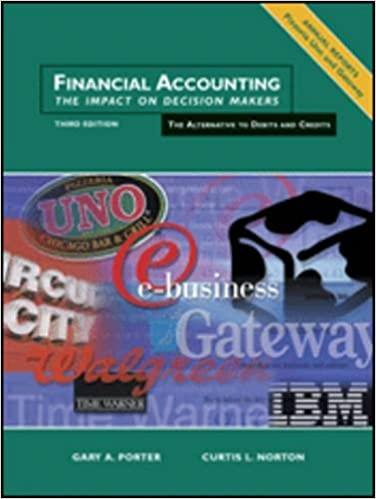


Faubert Company began operations on January 1, Year 1. The company has drafted its Year 5 comparative financial statements. Adjusting Journal Entries have been recorded; the Year 5 books are still open. Faubert will be audited for the first time. Auditors have discovered the following possible errors: a. Faubert purchased a machine on June 30, Year 2, paying $30,000 cash. The machine has a salvage value of $5,000 and a useful life of 5 years. The bookkeeper recorded straight-line depreciation for each year through Year 5, but failed to consider the salvage value. b. The physical inventory count on December 31, Year 4, improperly excluded merchandise costing $5,000 that had been temporarily stored in a public warehouse. Faubert uses a periodic inventory system. C. An $18,000 insurance premium was paid on October 1, Year 4, for a policy that expires on September 30, Year 7. The premium was charged to Insurance Expense when paid. No adjustments have been recorded since the payment date. d. Accrued wages payable to employees of $3,500 were not recorded on December 31, Year 4. This amount was expensed when paid in January, Year 5. e. Faubert sold land on December 31, Year 3, for $20,000, which was $2,000 above book value. Faubert recorded this journal entry: Cash 20,000 Land 18,000 Retained Earnings 2,000 f. Faubert rented office space to Blake Company on January 1, Year 3. Faubert received an advanced payment of $40,000 on that date; the payment covered the Years 3 through 6. Faubert recorded this journal entry on January 1, Year 3: Cash 40,000 40,000 Rent Payable No journal entries related to this rent have been recorded since the initial cash receipt on January 1, Year 3. g. Faubert failed to accrue $10,000 of Interest Revenue for interest earned in Year 2. Revenue was recorded when the cash collection was received in Year 3. h. Faubert exchanged an old machine for a similar machine on December 31, Year 5. Original cost of the old machine was $66,000; Updated accumulated depreciation was $30,000. The newer machine had a fair value of $38,000; Faubert received $2,000 in the exchange. The exchange did not have commercial substance, but Faubert recorded the event as if the event had commercial substance. i. The Allowance for Doubtful Accounts has been based on a 2% uncollectible rate for several years, including Year 5 and Year 4. However, further analysis of the 12/31 Year 4 Accounts Receivable revealed that 2.2% of those receivables were not collected. Faubert chose to again use the 2% rate to determine the 12/31 Year 5 Allowance account, believing that 2% is the most representative rate for the uncollectible account balance at that date. j. Installment payments on Faubert's long-term debt begin in Year 6; $10,000 is due each year for four years. Faubert does not intend to make the Year 6 scheduled payment; the Year 6 and Year 7 amounts will be paid in Year 7, including interest and penalties totaling $2,720. Faubert Company Income Statements For Year Ended December 31 Year 5 For Year Ended December 31 Year 4 Sales Cost of Goods Sold $850,000 (340,000) $800,000 (400,000) Gross Profit $510,000 $400,000 Operating Expenses: Insurance (9,000) (29,000) Wages Depreciation (229,000) (140,000) (230,000) (130,000) Income from Operations $132,000 $11,000 Other Revenues and Expenses: Interest Revenue Bad Debt Expense Rent Revenue Gain on Exchange of Machine 28,000 (4,300) 23,000 4,000 30,000 (4,400) 25,000 Net Income $182,700 $61,600 Faubert Company Balance Sheets December 31, Year 5 December 31, Year 4 Assets Current Assets Cash and Equivalents Receivables (net of allowance) Inventories Prepaid Expenses and Other Assets Total Current Assets $580,100 220,500 85,000 30,300 915,900 $340,000 196,000 75,000 22,500 633,500 Land Plant and Machines, Net Other Assets Total Assets 72,000 320,000 28,300 $1,336,200 90,000 275,000 29,800 $1,028,300 Liabilities and Shareholders' Equity Current Liabilities Accounts Payable Rent Payable Unearned Revenue Wages Payable Current Portion of Long-Term Debt Total Current Liabilities $59,000 61,000 4,000 17,000 10,000 151,000 $10,400 43,000 3,000 2,400 -O- $58,800 Long-Term Debt Total Liabilities 30,000 $181,000 40,000 98,800 Shareholders' Equity Common Stock Additional Paid-In Capital Retained Earnings Treasury Stock (at cost) Total Shareholders' Equity Total Liabilities and Shareholders' Equity 100,000 792,000 314,100 (50,900) 1.155 200 $1,336,200 100,000 749,000 131,400 (50,900) 929,500 $1,028,300 REQUIRED 1. Correcting journal entries, if applicable, for items a. through j. If no correcting journal entry is needed, indicate "No CJE." Corrected and restated Year 5/Year 4 Faubert comparative income statement and balance sheet. 2









